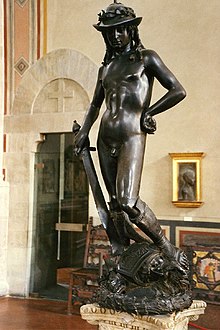
Back Donatello Afrikaans Donatello AN دوناتيلو Arabic دوناتيلو ARZ Donatello AST Donatello Azerbaijani Donatels BAT-SMG Данатэла Byelorussian Данатэльлё BE-X-OLD Донатело Bulgarian
Donatello | |
|---|---|
 Donatello, an imagined 16th-century portrait by an unknown artist[1] (The former attribution to Paolo Uccello is no longer accepted.) | |
| Born | Donato di Niccolò di Betto Bardi c. 1386 |
| Died | 13 December 1466 (aged 79–80) Republic of Florence |
| Nationality | Florentine |
| Known for | Sculpture |
| Notable work | Saint George David Equestrian Monument of Gattamelata |
| Movement | Early Renaissance |

Donato di Niccolò di Betto Bardi (c. 1386 – 13 December 1466), known mononymously as Donatello (English: /ˌdɒnəˈtɛloʊ/[2] Italian: [donaˈtɛllo]), was an Italian sculptor of the Renaissance period.[3] Born in Florence, he studied classical sculpture and used his knowledge to develop an Early Renaissance style of sculpture. He spent time in other cities, where he worked on commissions and taught others; his periods in Rome, Padua, and Siena introduced to other parts of Italy the techniques he had developed in the course of a long and productive career. His David was the first freestanding nude male sculpture since antiquity; like much of his work it was commissioned by the Medici family.
He worked with stone, bronze, wood, clay, stucco, and wax, and used glass in inventive ways. He had several assistants, with four perhaps being a typical number.Ref. ? Although his best-known works are mostly statues executed in the round, he developed a new, very shallow, type of bas-relief for small works, and a good deal of his output was architectural reliefs for pulpits, altars and tombs, as well as Madonna and Childs for homes.
Broad, overlapping, phases can be seen in his style, beginning with the development of expressiveness and classical monumentality in statues, then developing energy and charm, mostly in smaller works. Early on he veered away from the International Gothic style he learned from Lorenzo Ghiberti, with classically informed pieces, and further on a number of stark, even brutal pieces. The sensuous eroticism of his most famous work, the bronze David, is very rarely seen in other pieces.
- ^ Unknown master (19 December 2023). "Cinq maîtres de la Renaissance florentine : Giotto, Uccello, Donatello, Manetti, Brunelleschi" [Five masters of the Florentine renaissance]. Le Louvre.
- ^ Wells, John (3 April 2008). Longman Pronunciation Dictionary (3rd ed.). Pearson Longman. ISBN 978-1-4058-8118-0.
- ^ Though an Italian nation state had yet to be established, the Latin equivalent of the term Italian (italus) had been in use for natives of the region since antiquity. For example in Pliny the Elder, Letters 9.23.
© MMXXIII Rich X Search. We shall prevail. All rights reserved. Rich X Search